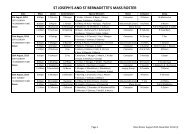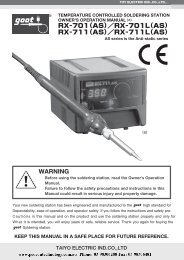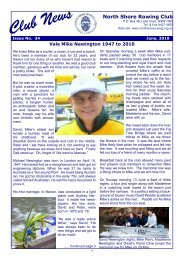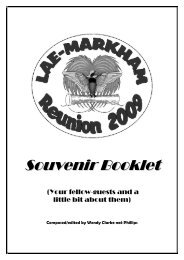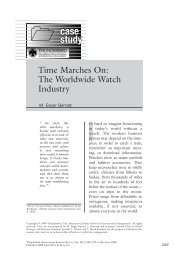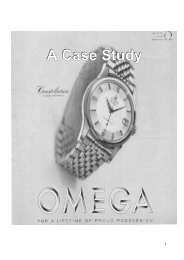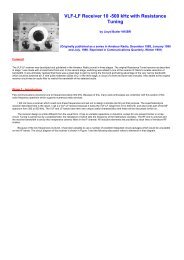Hatchability of the Modern Exhibition Budgerigar - Tpg
Hatchability of the Modern Exhibition Budgerigar - Tpg
Hatchability of the Modern Exhibition Budgerigar - Tpg
You also want an ePaper? Increase the reach of your titles
YUMPU automatically turns print PDFs into web optimized ePapers that Google loves.
<strong>Hatchability</strong> <strong>of</strong> <strong>the</strong> <strong>Modern</strong> <strong>Exhibition</strong> <strong>Budgerigar</strong><br />
By Ken Yorke (2011)<br />
Being competitive with exhibition budgerigars is about managing quality <strong>of</strong> bird. Quality generally<br />
relates to managing traits, bloodlines and <strong>the</strong> skill <strong>of</strong> pair selection. Even <strong>the</strong> most consistent<br />
bloodline <strong>of</strong> quality pairs will produce a range <strong>of</strong> differing quality chicks, as can be expected by<br />
genetic variability. Despite all <strong>the</strong> skill <strong>of</strong> <strong>the</strong> breeder we are still bound by some degree <strong>of</strong> probability<br />
and statistics which means that in order to maximise <strong>the</strong> number <strong>of</strong> good quality <strong>of</strong>fspring that a pair<br />
can produce <strong>the</strong>n we need to maximise <strong>the</strong> total number <strong>of</strong> chicks produced from any particular pair.<br />
In simple terms, if a pair <strong>of</strong> birds produces 4 chicks (2 good and 2 poor) in a clutch, <strong>the</strong>n at <strong>the</strong> end <strong>of</strong><br />
<strong>the</strong> season you will have 2 good birds to show and breed with next season. If <strong>the</strong> same pair instead<br />
produces 6 chicks (3 good and 3 poor) <strong>the</strong>n you now have 3 good birds to show and breed with<br />
instead <strong>of</strong> 2. The more birds you breed <strong>the</strong>n, on average, <strong>the</strong> more good birds you have to select from<br />
for showing and future breeding. The point <strong>of</strong> this simple <strong>the</strong>oretical exercise is to show that in order<br />
to manage quality <strong>of</strong> birds it is also advantageous to maximise quantity.<br />
To breed more birds you could i) buy more pairs and increase <strong>the</strong> number <strong>of</strong> breeding cages, or ii)<br />
increase <strong>the</strong> number <strong>of</strong> clutches from existing pairs or iii) improve <strong>the</strong> reproductive ability <strong>of</strong> existing<br />
pairs. Option i) above is expensive, option ii) causes more wear and tear on birds and may even<br />
shorten <strong>the</strong>ir breeding life. This article will address option iii), maximising quantity through examining<br />
hatchability <strong>of</strong> <strong>the</strong> modern exhibition budgerigar.<br />
In <strong>the</strong> last few decades, many <strong>the</strong>ories and anecdotes abound about <strong>the</strong> perceived drop <strong>of</strong>f in fertility<br />
<strong>of</strong> <strong>the</strong> exhibition budgerigar brought about perhaps by inbreeding and/or increased fea<strong>the</strong>r length<br />
interfering with <strong>the</strong> physical act <strong>of</strong> mating. However, very little factual evidence exists to confirm or<br />
deny such claims.<br />
In order to establish some benchmarks I extracted some data from my own breeding records.<br />
Table 1<br />
No <strong>of</strong> eggs 12,830<br />
No <strong>of</strong> years 21<br />
% eggs hatched (<strong>Hatchability</strong>) Yearly Average 38% (Std Dev +/- 7%)<br />
% hatchlings survive (Rearability) Yearly Average 70% (Std Dev +/- 9%)<br />
This means that for every 100 eggs laid, 38 chicks will hatch and <strong>of</strong> <strong>the</strong>se chicks, 27 will survive.<br />
These numbers may seem small but <strong>the</strong> truth is that few people ever measure such statistics and<br />
would probably be surprised to get similar results if <strong>the</strong>y did.<br />
True egg fertility is difficult to measure without scientific instruments as some fertile eggs die at such<br />
an early stage <strong>the</strong>y appear clear. <strong>Hatchability</strong>, on <strong>the</strong> o<strong>the</strong>r hand, is very easy to measure, eggs ei<strong>the</strong>r<br />
hatch or <strong>the</strong>y don’t.<br />
In a smaller sample <strong>of</strong> data (2,009 eggs) where an attempt was made to examine <strong>the</strong> cause <strong>of</strong> nonhatching<br />
eggs, <strong>the</strong> following approximate data was realised.<br />
Table 2<br />
Clear 44%<br />
Broken/Damaged 8%<br />
Addled/Dead in Shell 10%<br />
Hatched 38%<br />
The data in Table 2 should be regarded as approximate only, with <strong>the</strong> true percentage <strong>of</strong> clear eggs<br />
probably being lower and <strong>the</strong> addled/dead in shell being higher.
For eggs to hatch <strong>the</strong>y must first be fertilised. Infertile (clear) eggs can have two main causes with<br />
numerous possible sub-causes such as, but not limited to:-<br />
i) Temporary or permanent sterility (including reduced fertility) due to<br />
a) Old age<br />
b) Illness<br />
c) Moult<br />
d) Out <strong>of</strong> condition<br />
e) Stress<br />
ii) Failure to mate due to<br />
a) Breeding cage deficiencies<br />
b) Excess fea<strong>the</strong>ring<br />
c) Lack <strong>of</strong> libido<br />
d) Physical disability<br />
Age<br />
The same raw data used to construct Table 1 was also analysed to assess <strong>the</strong> effect <strong>of</strong> parent age on<br />
hatchability. This is shown in Table 3.<br />
Table 3<br />
Age (years) 0-1 1-2 2-3 3-4 4-5 5-6 6-7<br />
Cock <strong>Hatchability</strong> 35% 39% 38% 38% 37% 33% 20%<br />
Hen <strong>Hatchability</strong> 35% 40% 37% 36% 28% 37% 0%*<br />
(* Small sample <strong>of</strong> data)<br />
Surprisingly <strong>the</strong>re is no dramatic drop <strong>of</strong>f in hatchability until <strong>the</strong> age is 6 to 7 years. A very slight peak<br />
appears in <strong>the</strong> 1-2 year age group but this is minimal.<br />
Breeding Season<br />
Unlike most breeders, I allow my birds to breed at any time <strong>of</strong> year, i.e. I do not have a defined<br />
breeding season. I have birds breeding twelve months a year. All <strong>the</strong> above data reflects this 12<br />
month a year breeding time. Many years ago I colony bred and again allowed <strong>the</strong> birds to breed any<br />
time <strong>the</strong>y liked in a twelve month period. In <strong>the</strong> colony system it was obvious that <strong>the</strong> birds willingness<br />
to breed was always much higher in spring than any o<strong>the</strong>r time. But that is not to say that those birds<br />
that did choose to breed outside spring bred poorly. Is <strong>the</strong>re a best time <strong>of</strong> year to breed in order to<br />
maximise quantity? Are <strong>the</strong>re periods to avoid, such as moult etc.? Table 4 shows <strong>the</strong> results <strong>of</strong> a<br />
data study.<br />
Table 4<br />
Month Jan Feb Mar Apr May Jun Jul Aug Sep Oct Nov Dec<br />
<strong>Hatchability</strong> 35% 36% 39% 37% 36% 42% 39% 38% 36% 37% 36% 31%<br />
Table 4 shows no dramatically good or bad months to breed. This surprisingly shows that <strong>the</strong>re is no<br />
special benefit to breeding in spring (i.e. Sep-Nov for <strong>the</strong> Australian climate in <strong>the</strong> above data). Past<br />
colony breeding showed increased preference for breeding in spring but if <strong>the</strong> birds chose (or are<br />
forced) to breed outside spring, <strong>the</strong>n <strong>the</strong>ir actual hatchability is unchanged. In o<strong>the</strong>r words, <strong>the</strong> natural<br />
desire to breed is stronger in spring but <strong>the</strong> actual hatchability achieved doesn’t vary with time <strong>of</strong> year.<br />
Likewise, <strong>the</strong> major moults in April and October have little effect on hatchability. There is however, a<br />
major proviso to <strong>the</strong> moult situation. Practical experience has shown that birds which are paired up<br />
immediately before or during <strong>the</strong>ir major moults tend to have poor fertility and hatchability but this is<br />
not reflected in <strong>the</strong> data above. This is because I avoid pairing up in <strong>the</strong>se moult periods, but I instead<br />
pair up considerably before <strong>the</strong> moult and breed successfully through <strong>the</strong> moult period. Birds which<br />
are breeding successfully well before <strong>the</strong> moult commences actually substantially skip <strong>the</strong> moult and<br />
thus do not get most <strong>of</strong> <strong>the</strong> downside effects <strong>of</strong> <strong>the</strong> moult. When breeding finishes, <strong>the</strong>y <strong>of</strong>ten<br />
immediately moult in order to catch up on <strong>the</strong> moult <strong>the</strong>y missed.
The o<strong>the</strong>r proviso on <strong>the</strong> Table 4 data is that this applies to a mild Australian climate. Breeding<br />
outside <strong>of</strong> spring in harsher climates may bring reduced hatchability.<br />
Large Fea<strong>the</strong>rs<br />
The next issue to look at is <strong>the</strong> perceived issue <strong>of</strong> excess vent fea<strong>the</strong>ring preventing fertilisation<br />
during <strong>the</strong> act <strong>of</strong> mating. This has received a lot <strong>of</strong> press in <strong>the</strong> last two decades, in particular due to<br />
<strong>the</strong> reasonably rapid rise to prominence <strong>of</strong> large fea<strong>the</strong>red birds in <strong>the</strong> exhibition arena. To alleviate<br />
this possible problem many breeders pluck or cut <strong>the</strong> fea<strong>the</strong>rs around <strong>the</strong> vent <strong>of</strong> each bird prior to<br />
pairing up. This however is not strictly a modern practice as I know breeders who have done this for<br />
over fifty years (long before <strong>the</strong> long fea<strong>the</strong>r fad). Many breeders do not admit to this practice<br />
however, as to some, it feels like a stigma, admitting that <strong>the</strong>ir strain <strong>of</strong> birds has a fertility problem.<br />
So, is <strong>the</strong>re any truth to large fea<strong>the</strong>rs causing mating problems and is plucking or trimming a<br />
preventative.<br />
In Australia <strong>the</strong> number <strong>of</strong> exhibition birds with large fea<strong>the</strong>rs increased dramatically with <strong>the</strong><br />
importation <strong>of</strong> birds from England in <strong>the</strong> early 1990’s and later indirectly from continental Europe. In<br />
my case <strong>the</strong> introduction <strong>of</strong> birds with imported ancestry was a gradual process and I kept many<br />
Australian exhibition strains going (particularly in <strong>the</strong> very rare varieties, as one had no alternative but<br />
persevere with <strong>the</strong> “older style” Australian bird). This gives me a reasonably unique ability to compare<br />
<strong>the</strong> breeding capability <strong>of</strong> large and short fea<strong>the</strong>red birds at <strong>the</strong> same time. Graph 1 below shows <strong>the</strong><br />
hatchability <strong>of</strong> imported birds and Australian birds and also <strong>the</strong> combined hatchability <strong>of</strong> all birds from<br />
1996 to 2010. Superimposed on this is a line showing <strong>the</strong> gradual increase in <strong>the</strong> percentage <strong>of</strong><br />
breeding pairs with imported ancestry in my whole aviary.<br />
100%<br />
90%<br />
80%<br />
70%<br />
60%<br />
50%<br />
40%<br />
30%<br />
20%<br />
10%<br />
0%<br />
Graph1 -<strong>Hatchability</strong><br />
All <strong>Hatchability</strong><br />
Imported Hatchabilty<br />
Australian <strong>Hatchability</strong><br />
No <strong>of</strong> Imported Pairs<br />
Graph1 shows a few features:-<br />
i) 1996 was a one-<strong>of</strong>f poor year. This can be easily explained as this was <strong>the</strong> year <strong>the</strong> birds<br />
were moved from one residence to ano<strong>the</strong>r and was <strong>the</strong>ir first year in a completely new<br />
and quite different aviary. Stress <strong>of</strong> relocation and slight climate change is a major factor.<br />
ii) The percentage <strong>of</strong> pairs with imported ancestry increases from 9% in 1996 to 95% in<br />
2010. While not every bird with imported ancestry necessarily has large fea<strong>the</strong>ring, it<br />
does however reflect <strong>the</strong> general increase (with a probable time delay) in <strong>the</strong> percentage<br />
<strong>of</strong> birds with large fea<strong>the</strong>ring over time.<br />
iii) In <strong>the</strong> 12 year period from 1997 to 2008 where <strong>the</strong>re is sufficient data to make a<br />
meaningful comparison between imported and Australian birds, it is noticeable that <strong>the</strong><br />
Australian birds had better hatchability than <strong>the</strong> imported birds in 10 out <strong>of</strong> 12 years.<br />
iv) Overall hatchability across all birds peaked in 2000 and had a continual slight decline until<br />
2007 followed by a dramatic decline from 2008 to 2010.
A conclusion that can perhaps be drawn from this is that imported birds generally had poorer<br />
hatchability than Australian birds and <strong>the</strong> more imported birds one had breeding over time, <strong>the</strong> worse<br />
<strong>the</strong> overall hatchability <strong>of</strong> <strong>the</strong> whole aviary became. What <strong>the</strong>n is <strong>the</strong> reason for <strong>the</strong> poorer hatchability<br />
in imported birds? Is it genetic predisposition to poor hatchability or is it large fea<strong>the</strong>ring?<br />
If large fea<strong>the</strong>ring is <strong>the</strong> cause <strong>the</strong>n <strong>the</strong> practice <strong>of</strong> plucking vent fea<strong>the</strong>rs should help. In 2008<br />
through 2010 I tried plucking <strong>the</strong> vent fea<strong>the</strong>rs from my pairs (a practice I previously did not do).<br />
Graph 1 above shows that this 2008 through 2010 period was dramatically bad for hatchability. As<br />
with lots <strong>of</strong> statistics, it should not be taken at face value. Fea<strong>the</strong>rs are plucked when <strong>the</strong> birds are<br />
first paired up. These same fea<strong>the</strong>rs start to grow back within two weeks and are usually fully grown<br />
back by about 5 weeks. This means that <strong>the</strong> plucking only has any potential benefit for <strong>the</strong> first<br />
breeding round only. Second and later rounds have <strong>the</strong> fea<strong>the</strong>rs grown back unless <strong>the</strong>y are plucked<br />
again.<br />
Table 5 looks at hatchability data for three years without plucking and three years with plucking but<br />
also looking on a round by round basis.<br />
Table 5<br />
Year Round 1 Round 2 Round 3 Round 4<br />
2005 Not 32% 36% 47% 44%<br />
2006 Plucked 37% 36% 32% 55%<br />
2007 33% 40% 31% 55%<br />
2008 Plucked<br />
1 st<br />
33% 32% 18% 22%<br />
2009 28% 18% 15% 19%<br />
2010 Round 28% 21% 17% 47%<br />
In this data <strong>the</strong> round 4 hatchability is generally very good compared to earlier rounds, which would<br />
seem unexpected. This can be explained because almost all pairs in my breeding program have two<br />
rounds and it is very common to have three rounds, only those exceptional pairs who have already<br />
displayed good breeding behaviour in <strong>the</strong> first three rounds are permitted to have a fourth round. Thus<br />
round 4 hatchability data in table 5 is biased toward good hatchability and thus should not be<br />
compared against earlier rounds. Although it does display what levels <strong>of</strong> hatchability can be achieved<br />
by <strong>the</strong> best breeding pairs and thus sets a goal (about 55%) for all pairs to strive.<br />
In <strong>the</strong> first three years where no plucking was performed <strong>the</strong>re is no obvious trend from 1 st to 3 rd<br />
round. It is a mix <strong>of</strong> slightly up and down or near level. In <strong>the</strong> last three years where plucking was<br />
performed in <strong>the</strong> first round, <strong>the</strong> trend is always worse in 2 nd and 3rd rounds This tends to suggest<br />
that plucking before <strong>the</strong> first round improved <strong>the</strong> hatchability <strong>of</strong> <strong>the</strong> first round, and hatchability<br />
deteriorated in <strong>the</strong> later rounds when not plucked. Therefore, plucking fea<strong>the</strong>rs does seem to work. Is<br />
<strong>the</strong>re a case now to pluck <strong>the</strong> birds again before <strong>the</strong> second and third rounds? The advantage <strong>of</strong><br />
cutting fea<strong>the</strong>rs with scissors instead <strong>of</strong> plucking would mean that you only need to do this once per<br />
season instead <strong>of</strong> each round as cut fea<strong>the</strong>rs do not immediately regrow. The disadvantage to cutting<br />
is that it usually leaves <strong>the</strong> sharp stumps <strong>of</strong> quills behind and this can have a “porcupine” effect which<br />
can make <strong>the</strong> act <strong>of</strong> mating awkward or painful and <strong>of</strong> course this leads to failure to mate and poor<br />
hatchability. Data on cut fea<strong>the</strong>rs is a research project for <strong>the</strong> future.<br />
Again looking at Table 5, despite plucking <strong>the</strong> 1 st round in <strong>the</strong> final three years, hatchability levels<br />
were still <strong>the</strong> worst <strong>of</strong> any previous years going back to 1996 (and probably would have been worse<br />
again had I not plucked fea<strong>the</strong>rs). So despite <strong>the</strong> large fea<strong>the</strong>rs being detrimental to hatchability <strong>the</strong>re<br />
must also be ano<strong>the</strong>r factor contributing to a decline in hatchability. Such things could be a bloodline<br />
genetic deficiency or even a decline in husbandry and housekeeping standards by <strong>the</strong> owner (It’s not<br />
always solely <strong>the</strong> bird’s fault). Genetic deficiency can be addressed by culling birds for poor breeding<br />
ability as well as poor quality.<br />
Failure to Hatch<br />
Assuming that an egg is fertilised <strong>the</strong>n <strong>the</strong>re are still reasons why it will not hatch such as, but not<br />
limited to:-<br />
i) Damaged or broken eggs due to
a) Nest box design<br />
b) Parent breakage<br />
c) Human breakage<br />
ii) Addled or dead in shell due to<br />
a) Malformed eggs<br />
b) Environment<br />
c) Genetic weakness<br />
d) Poor incubation<br />
e) Poor housekeeping<br />
f) Poor nutrition<br />
g) Disease<br />
Of <strong>the</strong>se I will concentrate on <strong>the</strong> addled and dead in shell and some <strong>of</strong> <strong>the</strong> measures we can take to<br />
minimise <strong>the</strong>se issues and hence improve hatchability.<br />
Malformed eggs (including too big/small or porous) can be <strong>the</strong> fault <strong>of</strong> poor nutrition or poor health<br />
including old age and tumours etc. Hens which continually produce malformed eggs should be culled.<br />
Environment causes include incorrect humidity, air temperature and presence <strong>of</strong> chemicals (e.g.<br />
poisons, pesticide strips etc). If <strong>the</strong> membrane inside <strong>the</strong> egg shell dries out <strong>the</strong>n <strong>the</strong> fully formed<br />
chick inside <strong>of</strong>ten gets stuck to <strong>the</strong> shell and cannot rotate around inside <strong>the</strong> shell to chip out,<br />
resulting in dead in shell.<br />
Genetic weakness includes predisposition for unhealthy embryos and lethal genes. Families<br />
displaying <strong>the</strong>se traits should be culled.<br />
Poor incubation is primarily <strong>the</strong> fault <strong>of</strong> <strong>the</strong> hen, including spending too much time outside <strong>of</strong> nest, or<br />
not consistently sitting on eggs until several have been laid. Although night fright, vermin, illness and<br />
bad food can also cause hens to stop sitting for periods.<br />
Poor housekeeping relates to clean nest boxes. Nests do not have to be spotless but too many<br />
droppings (particularly from previous chicks and parents) can partially bury eggs. Eggs need to roll<br />
around a small amount in order for <strong>the</strong> embryos to develop in <strong>the</strong> correct position inside <strong>the</strong> egg.<br />
Conversely if <strong>the</strong>y roll around too much (in <strong>the</strong> case <strong>of</strong> flat bottom nests or parents who play soccer<br />
with eggs) <strong>the</strong>n <strong>the</strong> embryos get damaged. Wet nests also can contaminate eggs, as egg shells are<br />
porous and do absorb chemicals from <strong>the</strong> environment.<br />
Poor nutrition relates primarily to <strong>the</strong> hen before <strong>the</strong> egg is laid. All <strong>the</strong> nutrients <strong>the</strong> embryo requires<br />
are deposited by <strong>the</strong> hen inside <strong>the</strong> egg. If <strong>the</strong> hen has a deficient diet <strong>the</strong>n <strong>the</strong> embryo will also be<br />
deficient.<br />
Eggs are porous and can in some instances get diseases from <strong>the</strong>ir environment.<br />
Many <strong>of</strong> <strong>the</strong>se failure to hatch examples above deserve full research in <strong>the</strong>ir own right and require<br />
somewhat more scientific knowledge than <strong>the</strong> layman possesses. Similarly I have not addressed <strong>the</strong><br />
next stage, rearability, i.e. <strong>the</strong> raising and survival <strong>of</strong> a newly hatched chick to adulthood.<br />
Summary<br />
In order to breed quality birds you require parent birds capable <strong>of</strong> producing quality chicks. In order to<br />
breed lots <strong>of</strong> quality birds <strong>the</strong>n it is advantageous to have parent birds capable <strong>of</strong> producing lots <strong>of</strong><br />
chicks. One aspect <strong>of</strong> producing lots <strong>of</strong> chicks is to maximise <strong>the</strong> hatchability <strong>of</strong> parent birds. Table 6<br />
below summarises things we can do to help achieve that goal <strong>of</strong> maximising hatchability.
Table 6<br />
Issue Remedy<br />
Age Parents less than 6 years old. Slight preference for 1 – 2 years old.<br />
Illness/Disease Do not use ill birds, nor birds with inadequate recovery time from<br />
previous illness.<br />
Moult Do not pair up birds which are actually moulting. Pair up after <strong>the</strong><br />
moult or considerably before <strong>the</strong> moult and breed through <strong>the</strong><br />
moult period.<br />
Out <strong>of</strong> condition Do not pair up birds out <strong>of</strong> condition. Wait until <strong>the</strong>y have an active<br />
libido. Check for latent illness.<br />
Stress Do not pair up birds which are undergoing stress (e.g.<br />
overshowing, disease recovery, changed location, changed diet<br />
etc)<br />
Breeding Cage Ensure enough space for <strong>the</strong> act <strong>of</strong> mating to take place<br />
comfortably. Ensure perches are solid, with good grip and<br />
appropriate size.<br />
Excess Vent Fea<strong>the</strong>ring Pluck large vent fea<strong>the</strong>rs before each round. (or perhaps cut<br />
fea<strong>the</strong>rs before 1 st round)<br />
Lack <strong>of</strong> Libido Pair up only when active (Libido <strong>of</strong>ten increases in spring), or cull<br />
birds which continually have lack <strong>of</strong> libido.<br />
Physical Disability Cull birds with disabilities or modify cage design to better assist<br />
with act <strong>of</strong> mating.<br />
Breeding Season Time In harsh climates, breed in spring. In mild climates <strong>the</strong> time <strong>of</strong> year<br />
is irrelevant.<br />
Damaged Eggs No sharp objects or edges in nest box. Trim sharp nails and beaks<br />
<strong>of</strong> parents. Remove and transfer eggs from difficult parents as<br />
immediately laid. Minimise human handling <strong>of</strong> eggs.<br />
Malformed Eggs Ensure correct nutrition and exercise <strong>of</strong> hens. Cull repeat <strong>of</strong>fending<br />
hens<br />
Environment Remove hazardous chemicals from aviary. Monitor and adjust<br />
humidity (with open water containers). Monitor and adjust room<br />
temperature.<br />
Genetic Weakness Cull families with consistent poor hatchability.<br />
Poor Incubation Transfer eggs to o<strong>the</strong>r hens. Cull repeat <strong>of</strong>fenders. Ensure no<br />
distractions e.g. vermin, noises etc. Ensure no illness and good<br />
food,<br />
Nestbox Housekeeping Regularly clean nestbox <strong>of</strong> excess debris. Carefully clean eggs<br />
which are covered in droppings.<br />
Parent Nutrition Ensure good balanced diet before and during breeding.



